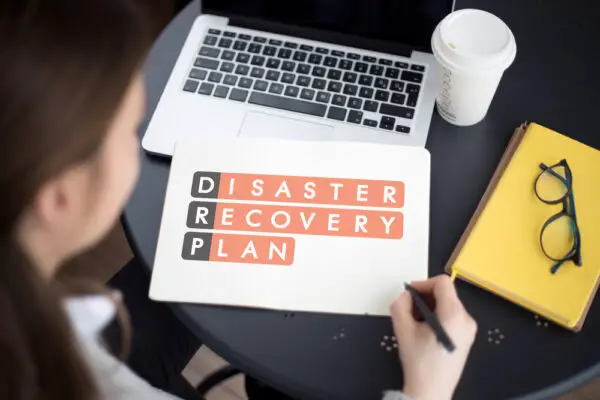In today’s fast-paced and uncertain business environment, the ability to swiftly respond and adapt to unforeseen disruptions is not just an advantage but a necessity.
This is where a well-structured Business Continuity Plan (BCP) becomes invaluable. A BCP is not merely a set of procedures to follow during a crisis; it’s a comprehensive strategy that ensures a business’s resilience and ongoing operations in the face of unexpected events.
However, writing an effective Business Continuity Plan can be daunting, especially for those unfamiliar with the process.
This blog post is designed to demystify and guide you through the critical steps of creating a robust and responsive BCP.
From understanding your business’s unique vulnerabilities to developing recovery strategies and ensuring employee readiness, we will cover the essential elements that make a BCP not only comprehensive but also practical and actionable.
Whether you’re a seasoned professional in risk management or a newcomer to enterprise resilience planning, our insights will provide a clear roadmap to safeguard your business’s future.
Join us as we delve into the art and science of crafting a Business Continuity Plan that stands the test of time and uncertainty.
A BCP serves as a blueprint for navigating through unexpected disruptions, ensuring the continuity of critical operations, and minimizing potential financial losses.
An effective BCP provides insights into understanding their business, building a competent team, and crafting a comprehensive plan.
Businesses can improve their future success and resilience by adhering to these guidelines.

What is a Business Continuity Plan (BCP)?
A Business Continuity Plan (BCP) is a strategic document that outlines how an organization will continue its operations during and after a disruptive event.
It includes detailed procedures and protocols that ensure the organization can minimize downtime, recover critical functions, and maintain productivity.
Writing a BCP is essential for businesses to protect their employees, assets, and reputation, as well as to comply with industry regulations and demonstrate resilience to stakeholders.
Why Do You Need to Write a BCP?
One important reason to write a Business Continuity Plan (BCP) is to ensure the sustainability of your organization during unexpected disruptions.
A BCP is a proactive approach to identifying potential risks and developing strategies to mitigate the impact of a disruptive event on critical business functions.
Here are some key reasons why you need to write a BCP:
- Conducting a business impact analysis helps you understand the financial impact of a business disruption and prioritize critical functions.
- Risk assessments enable you to identify and assess potential risks to your organization.
- Disaster recovery planning ensures that you have the necessary procedures in place to recover and restore operations after a disruptive event.
- A BCP helps you establish a framework for business continuity management, ensuring that your organization can effectively respond to and recover from disruptive events.
- Writing a BCP helps you minimize the impact of a disruptive event on your organization, ensuring its long-term sustainability.
Understanding Your Business
To effectively write a business continuity plan, it is crucial to have a deep understanding of your business.
This involves identifying critical business functions, assessing potential risks and impacts, and developing contingency plans for disruptions.
Additionally, mapping out business processes and partnerships will provide a comprehensive view of your business’s operations, allowing you to create a more resilient and effective continuity plan.
Identifying Critical Business Functions
To properly identify critical business functions, conducting a comprehensive analysis of your organization’s operations is essential.
This step is crucial in the business continuity planning as it allows you to understand the key components that keep your business running.
Here are five key points to consider when identifying critical business functions:
- Assess your business operations: Review all areas of your organization, including finance, operations, customer service, and IT, to determine which functions are essential for your business to operate smoothly.
- Consider potential impacts: Identify the potential impacts that could disrupt your critical business functions, such as natural disasters, cyberattacks, or supply chain disruptions.
- Involve the business continuity team: Engage key stakeholders, including the business continuity team, to gather input and insights on critical functions and ensure alignment with the overall recovery strategy.
- Evaluate human resources: Determine which roles and skills are necessary to maintain critical functions and develop a plan to ensure their availability during a disruption.
- Analyze business processes: Identify the key processes that support critical functions and assess their vulnerabilities. Develop a contingency plan to address any weaknesses and minimize downtime.
Assessing Potential Risks and Impacts
Assessing potential risks and impacts is crucial in understanding your business when developing a business continuity plan.
Companies can proactively plan for potential disruptions by identifying and assessing risks.
This assessment helps organizations prioritize their critical business functions and allocate resources accordingly.
To assist in this process, a table can be used to visually represent the potential risks and their impacts on various aspects of the business.
This table can include columns such as ‘Risk’, ‘Impact on Operations’, and ‘Mitigation Strategies‘.
Businesses can minimize disruption and ensure continuity by analyzing risks.
Developing Contingency Plans for Disruptions
After assessing potential risks and impacts, the next step in developing a business continuity plan is to focus on developing contingency plans for disruptions, specifically in understanding your business.
This involves identifying the key components of your business, such as business functions and essential services, that need to be protected and restored in the event of a major disruption.
To effectively develop contingency plans, consider the following:
- Communication: Establish a communication plan to ensure timely and accurate dissemination of information during disruptions.
- Potential disruptions: Identify potential disruptions that could impact your business operations, such as natural disasters, cyber-attacks, or supply chain disruptions.
- Recovery time objectives: Determine the acceptable timeframe for restoring critical business functions and set recovery time objectives accordingly.
- Financial losses: Assess the potential financial losses that could occur due to a disruption and plan accordingly.
- Contingency planning: Develop strategies and actions to mitigate the impact of disruptions and ensure the continuity of your business.
To help with this process, consider utilizing business continuity plan templates that provide a framework for developing comprehensive contingency plans.
Mapping Out Business Processes and Partnerships
When mapping out business processes and partnerships, it is essential to gain a comprehensive understanding of your organization’s operations and external relationships.
This step is crucial in developing a robust business continuity plan that addresses potential disruptions effectively.
Take the time to identify and document all the key business units and their interdependencies. This will help you determine critical processes and the resources required to support them.
Additionally, establish clear communication channels and contacts for each business unit, ensuring everyone knows their roles and responsibilities during a crisis.
Furthermore, consider establishing backup plans and alternate resources to mitigate potential losses.
Lastly, review and update your policies regularly to ensure that they align with your emergency management objectives and address the needs of your business partners.
| Key Considerations | Actions | Impact |
|---|---|---|
| Identify critical processes | Document interdependencies | Understand which processes are essential |
| Establish communication | Designate contacts | Enable efficient communication during crises |
| Develop backup plans | Identify alternate resources | Reduce potential losses |
Building Your Team
To successfully build a strong team for your business continuity plan (BCP), it is crucial to define the responsibilities of each team member.
This includes selecting senior management to provide support and oversight throughout the BCP process.
Additionally, training your employees on emergency management procedures is essential to ensure they are prepared to respond effectively in times of crisis.
Defining Responsibilities of the BCP Team
How can you effectively define the responsibilities of your Business Continuity Planning (BCP) team?.
To ensure the smooth functioning of your organization during crises, it is crucial to clearly outline your BCP team’s roles and responsibilities. Here are five key steps to defining their responsibilities:
- Develop a comprehensive business continuity plan outlining the team’s roles and responsibilities.
- Assign a team leader who will oversee the plan’s implementation and act as the main point of contact for senior management.
- Create a contact list that includes all team members, emergency responders, and key organisational stakeholders.
- Establish a clear time frame for each team member’s duties and ensure they understand their individual deadlines and expectations.
- Emphasize the importance of customer service and the need to address any disruptions promptly to avoid potential regulatory fines or reputational damage.
Selecting Senior Management for Support and Oversight
Senior management plays a crucial role in providing support and oversight in the process of building your business continuity team.
Selecting the right individuals for these positions is essential to ensure the success of your business continuity plan.
When choosing senior management for support and oversight, it is important to consider their expertise, experience, and commitment to the organization’s goals.
The table below provides a framework for selecting senior management that is contextually relevant to the article section:
| Criteria | Description | Importance |
|---|---|---|
| Expertise | In-depth knowledge of business operations and risk management | High |
| Experience | Previous involvement in crisis management or disaster recovery | Medium |
| Commitment | Willingness to allocate resources and prioritize business continuity efforts | High |
Training Employees on Emergency Management Procedures
Employees must be trained on emergency management procedures to effectively build their business continuity team.
Training employees on these procedures is crucial for ensuring that everyone understands their role in the event of an emergency and can contribute to the successful implementation of the business continuity plan.
Here are some key points to consider when training employees on emergency management procedures:
- Provide contextually relevant training materials and resources.
- Conduct regular training sessions to reinforce knowledge and skills.
- Encourage active participation and engagement during training.
- Test employees’ understanding through simulated emergency scenarios.
- Continuously update and refine training materials based on feedback and lessons learned.
Crafting Your Plan
Crafting a business continuity plan involves several key points.
First, it is crucial to establish clear goals and objectives for the plan, outlining what the organization wants to achieve during a disruptive event.
Second, documenting critical functions, resources, and processes is essential to understand the organization’s operations comprehensively.
Finally, setting up recovery strategies and backup plans is vital to minimize the impact of any potential disruptions.
Establishing Goals and Objectives of the BCP
To effectively craft a Business Continuity Plan (BCP), it is essential to establish clear and measurable goals and objectives.
These objectives will guide the development and implementation of the plan, ensuring that it adequately addresses the organization’s needs and priorities.
When setting the goals and objectives of your BCP, consider the potential risks and threats your business may face, such as extreme weather events or financial risks.
Identify the sources of these risks and determine the essential functions that must be protected in a disaster.
Your objectives should align with your overall business continuity strategy and aim to minimize the impact of severe weather or other disruptions.
Creating a business continuity plan with specific, measurable objectives can minimize downtime during disasters.

Key objectives to consider when establishing your BCP:
- Identify and prioritize essential functions and processes.
- Establish clear roles and responsibilities for BCP implementation.
- Develop strategies to mitigate risks and minimize disruptions.
- Ensure communication plans are in place to keep stakeholders informed.
- Test and regularly update the BCP to maintain its effectiveness.
Documenting Critical Functions, Resources, & Processes
When crafting your business continuity plan, it is crucial to document critical functions, resources, and processes to ensure the effective implementation of the plan.
This documentation clearly explains the essential activities and resources required to maintain operations during a crisis.
The business continuity management team, led by the business owner, should identify and prioritize these critical functions based on the level of risk and potential impact of external risks.
Key resources such as technology systems, equipment, and facilities should be documented to ensure their availability and functionality in the event of a catastrophic event.
Additionally, it is important to identify and document key employees who are essential for the continuity of operations to minimize the potential loss of productivity.
Emergency services should also be included in the plan to address any immediate response needs during an emergency situation.
Setting Up Recovery Strategies & Backup Plans
Implementing recovery strategies and backup plans is an essential aspect of crafting a business continuity plan.
A solid business continuity plan should include the following:
- External resources: Identify external resources, such as alternate suppliers or service providers, that can be leveraged during a disruption.
- Financial resources: Ensure that sufficient financial resources are available to support the recovery efforts, including funds for equipment replacement and operational expenses.
- Insurance policy: Review and update insurance policies to ensure adequate coverage for potential losses and liabilities.
- Communication plan: Develop a communication plan to keep stakeholders informed during an adverse event, including employees, customers, and vendors.
- Backup strategy: Establish a backup strategy for critical data and systems to minimize the impact of a disruption.
Incorporating these elements into your business continuity plan will enable you to effectively prepare for and respond to potential disruptions, minimizing revenue loss and ensuring operational continuity.
Additionally, consider forming a crisis management and customer support teams to streamline the recovery process.
Frequently Asked Questions
How Often Should a Business Continuity Plan Be Reviewed and Updated?
A business continuity plan should be reviewed and updated regularly to ensure its effectiveness and relevance.
The review and update process frequency may vary depending on factors such as industry regulations, organizational changes, and emerging threats and risks.
What Are the Key Components of a Business Continuity Plan?
The key components of a business continuity plan include a risk assessment, business impact analysis, recovery strategies, communication plans, and ongoing testing and maintenance.
These elements ensure an organization can effectively respond to and recover from disruptions.
How Can a Business Identify Its Critical Functions and Prioritize Them?
For a business to identify its critical functions and prioritize them, it is important to thoroughly assess the organization’s operations and dependencies to determine which areas are essential for maintaining continuity during a crisis or disruption.
What Are Some Common Challenges Businesses May Face When Implementing a Business Continuity Plan?
Some common challenges businesses may face when implementing a business continuity plan include lack of management support, insufficient resources, unclear roles and responsibilities, resistance to change, and difficulty maintaining and updating the plan.
Are There Any Legal or Regulatory Requirements for Having a Business Continuity Plan?
Yes, there are legal and regulatory requirements for having a business continuity plan. These requirements vary depending on the industry and jurisdiction, but organizations must comply with these mandates to ensure preparedness for potential disruptions and disasters.

Conclusion
Developing a business continuity plan is crucial for organizations to ensure the continuity of their operations during unforeseen events or disasters.
Businesses can minimize disruptions and maintain essential functions by assembling a dedicated team and crafting a comprehensive plan that aligns with their nature of business.
A well-executed business continuity plan protects the organization’s reputation and safeguards its stakeholders, employees, and assets.

Chris Ekai is a Risk Management expert with over 10 years of experience in the field. He has a Master’s(MSc) degree in Risk Management from University of Portsmouth and is a CPA and Finance professional. He currently works as a Content Manager at Risk Publishing, writing about Enterprise Risk Management, Business Continuity Management and Project Management.

